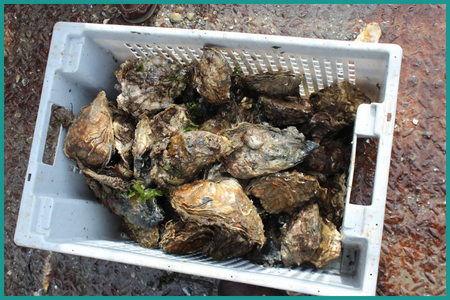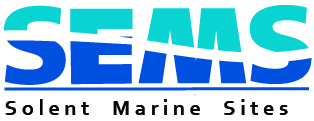Shore Based Fisheries

SEMS covers recreational fishing; this is fishing for the purposes of pleasure, tourism or sport from the shore or from a vessel. It is illegal to sell any of the catch from recreational fisheries. It includes crab tiling, bait digging, shellfish collection (including seed mussel) e.g. by hand (with or without digging apparatus), rake or through the use of 'tiles'. It also includes rod and line angling and the setting of pots and nets from the shore. Bait collectors have worked on the Solent coastline for many years and they have a legal right to collect bait for personal use. Collecting bait for commerical use requires the landowner's permission and is not covered by SEMS.
Bait collection from the intertidal zone causes varying degrees of physical damage and disturbance, as well as altering the community structure through removal of organisms. Two of the most common intertidal fishing activities are harvesting bivalves (e.g. Cerastoderma edule, Mercenaria mercenaria) and the lugworm (Arenicola marina). Hand collection methods for bait and bivalves are generally considered to have less impact on the environment than mechanical harvesting techniques. The worms, shellfish and other invertebrates which live in the sediment are an essential food supply for the birds, fish, crabs and shrimps living above them.
Gathering shellfish for personal consumption is permitted on licensed shellfish beds. There is no limit on the quantity that can be collected set in law, but the Food Standards Agency suggest a maximum of 5kg per person.
Management
Shellfish gathering is one of the sectors regulated by the Gangmasters and Labour Abuse Authority (GLAA). People that use or supply workers to gather shellfish need a GLAA licence.
Southern IFCA Officers carry out engagement and inspections of hand gathering activity and have a drone to assist with this, they also have shellfish gauges to ensure catch meets minimum size requirements. More information is available on their website - Shore Gathering : Southern IFCA (southern-ifca.gov.uk).
SIFCA have an intention to review shore gathering activities within MPAs (SACs, SPAs and MCZs) and Natural England will support this process. They have an intention to review shore gathering activities both within (e.g SSSIs) and outside of designated sites across the entire SIFCA district.
Southern IFCA's Net Fishing Byelaw has been developed following the Authority’s decision to review and develop regulations for the District’s harbours and estuarine waters in order to support the use of these areas as essential fish habitats, to provide protection to migratory salmonids as they transit through these areas, to balance the social and economic benefits of net fishers and to further the Conservation Objectives of Designated sites.
Under the Wildlife and Countryside Act 1981 it is an offence to intentionally or recklessly destroy, disturb or damage any of the features of a SSSI. The shore here is 'Littoral sediment' which is a feature of the SSSI. Without consent, shellfish harvesting could be considered as an 'Operation likely to damage' the site. Harvesters wishing to gather shellfish for commercial purposes within a SSSI must first seek the permission of the landowner/occupier. Before granting such permission, the landowner/occupier must get written consent from Natural England.
Impacts from Shore Based Fisheries
Natural England's conservation advice for the Solent Maritime SAC lists the pressure that could be exerted on intertidal habitats through shore based fishing activities like bait digging. These include trampling and erosion by people or vehicles, particularly on sensitive habitats like seagrass. Anchors can cause damage to the seabed surface and subsurface layers upon deployment/recovery and due to dragging or the vessel (including e.g. the propellor/wash) itself may cause abrasion if it comes into contact with the seabed in shallow water. Bycatch (i.e. discarded catch) is associated with almost all fishing activities. There are significant concerns over the impacts of discards on marine ecosystems, including changes in population abundance and demographics of affected species and altered species assemblages and food web structures. However, discards also provide important food resources for some scavenging species, including seabirds. The movement of vessels, vehicles and people, as well as that of gear, can create visual stimuli which can evoke a disturbance response in mobile species such as marine mammals, seabirds and coastal birds.
It is important for people to know what information to record when reporting bait digging as an issue, to help with this in 2018 the Sussex IFCA prepared a guidance note for the Solent's Relevant Authorities - Monitoring Shore Based Fishing Activities: Guidance for Solent Relevant Authorities.
Fareham Borough Council have published a useful guide to shellfish harvesting.
SEMS has produced a collector's code for bait digging, the key messages are:
- Observe local byelaws and regulations which affect the use of the coast, or access to permanently and seasonally closed areas.
- Collect bait sustainably.
- Back-fill all holes for safety, and to maintain the intertidal habitat.
- Tell someone where you intend to dig.
- Avoid disturbing wildlife and marine heritage wherever possible.
- Be aware of local hazards and conditions.
- Treat the foreshore with respect.
- Replace all rocks and stones, and preserve the food chain by not digging in seagrass beds.
- Do not dig around moorings, slipways, and sea walls.
- Take all your litter home.
Resources
- Southern IFCA information on hand gathering.
- Case study on Bait Management Collection in MPAs
- Monitoring Shore Based Fishing Activities: Guidance for Solent Relevant Authorities
- Poole Harbour Hand Shellfish Collection byelaw.
- Natural Engand video on mudflats and sandflats and the species that depend on them
- The Management of Hand Working Fishing Activity: A Focus on Bait Digging (Devon and Severn IFCA)
- University of Portsmouth Impact Cards - seagrass, saltmarsh, sediments and reefs
- Bait worms: a valuable and important fishery with implications for fisheries and conservation management (University of Portsmouth)
- Southern IFCA's Prohibition of Gathering (Sea Fisheries Resources) in Seagrass Beds Byelaw.
- Sussex IFCA's Chichester Harbour European Marine Site (Specified Areas) Prohibition of Fishing Method Byelaw.
- Angling Trust Factsheet - Bait Digging and the Law
- Angling Trust Bait Collector's Code
- Natural England report (2013) on how activity on intertidal soft sediments can cause damage or disturbance of the habitat from abrasion, penetration and removal.
- SEMS Bait Collector's Code
- University of Portsmouth Bait Collection papers.
- UK Marine SAC information on bait collection
-
University of Portsmouth academic paper - Successful local marine conservation requires appropriate educational
methods and adequate enforcement


